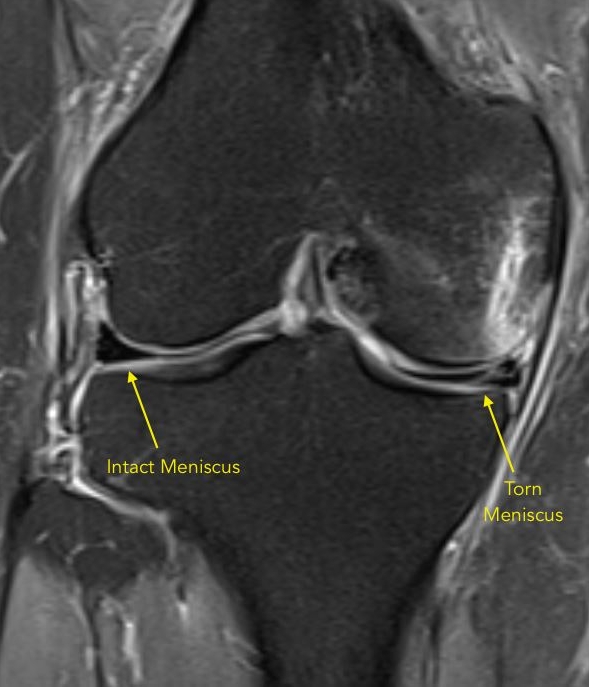Meniscus Tear
What are the symptoms of a meniscus tear?
Pain is the most common symptom of a meniscus. It is usually located in the area of the meniscus that is torn. Thus, if the medial meniscus (see anatomy below) is torn, the knee will be painful on the inner of the knee.
Swelling can also be associated with a meniscus tear. When there is enough swelling, it can become obvious over the top portion of the knee and will feel very "tight" when bending the knee.
Other symptoms may also include catching, locking, and giving way or "buckling". These usually mean that the portion of the tear is moving within the knee to cause it to behave abnormally.
What is the meniscus of the knee?
The meniscus is a structure that cushions the knee. It sits between the femur (thigh bone) and the tibia (shin bone).
It is composed of fibrocartilage but should not be confused for the cartilage that caps the ends of the bone (hyaline cartilage).
There is a meniscus on both the inner (medial) side and outer (lateral) side of each knee.
Each meniscus is thicker on the periphery and thins down and disappears as it extends to the center of the knee.
Looking top down on the meniscus of the knee. They are "C" shaped structures thicker on the periphery.
Knee Arthroscopy demonstrating normal meniscus compared to torn meniscus (bucket handle tear pattern).
What is the function of the meniscus?
The meniscus is designed to cushion the knee. It's primary role is to protect the cartilage cap on the ends of the femur and tibia.
The secondary function of the meniscus is to stabilize the knee although it is not very effective compared to the primary stabilizers of the knee (ie. ligaments).
How does the meniscus tear?
Meniscus tear types
The meniscus can tear in many ways. Most often, a tear occurs when there is a twisting or deep flexion (squat) type maneuver. This places the meniscus tissue under high load and it can fail.
Sometimes, the meniscus can tear over time without an obvious traumatic event
There are several types of meniscus tears.
How is a meniscus tear diagnosed?
MRI showing torn medial meniscus and intact lateral meniscus
Meniscus tears are typically diagnosed with a combination of patient history, physical examination and x-rays and MRI
The history and physical exam usually demonstrate pain at the joint line where the meniscus is located. Typical symptoms are listed above.
X-rays are needed to evaluate for fracture or arthritis
MRI is often performed to confirm the suspected tear of the meniscus.
What can be done about meniscus tear?
Meniscus repair performed arthroscopically. One method to repair a meniscus tear.
Treatment options for meniscus tears fall into a few camps:
Non-surgical: none of these will heal the tear, but can make the symptoms less
Anti-inflammatories - to decrease the inflammation, swelling in the knee
Cortisone (corticosteroid) injection - to decrease the inflammation
Physical Therapy - to maintain range of motion and strength in the knee. Other modalities can also decrease inflammation in the joint
Bracing - can decrease swelling and help the patient feel more "stable"
Surgical: surgery for meniscus tears can often decrease pain on a permanent basis. It is a relatively short, outpatient procedure that is minimally invasive (arthroscopic).
Partial meniscectomy: This is one of the most common procedures performed in orthopedics in the USA. This procedure involves removing the torn portion of the meniscus arthroscopically.
Does not typically require a brace afterwards
Faster recovery
Meniscus repair: This is where the torn portion of the meniscus is sewn back to the intact portion of the meniscus. This should only be performed with certain limited types of meniscus tears.
Typically requires brace after surgery
Longer recovery
Biologic/Regenerative treatment (experimental):
We have been asked more and more often about whether PRP injection or stem cell injection can be used to treat meniscus tears in the knee.
While these injections can be easily placed in the knee, there is little to no evidence to support the "healing" of the tear.
However, there are many patients who feel improved after receiving these injections (much like a cortisone injection) and are able to avoid surgery.



